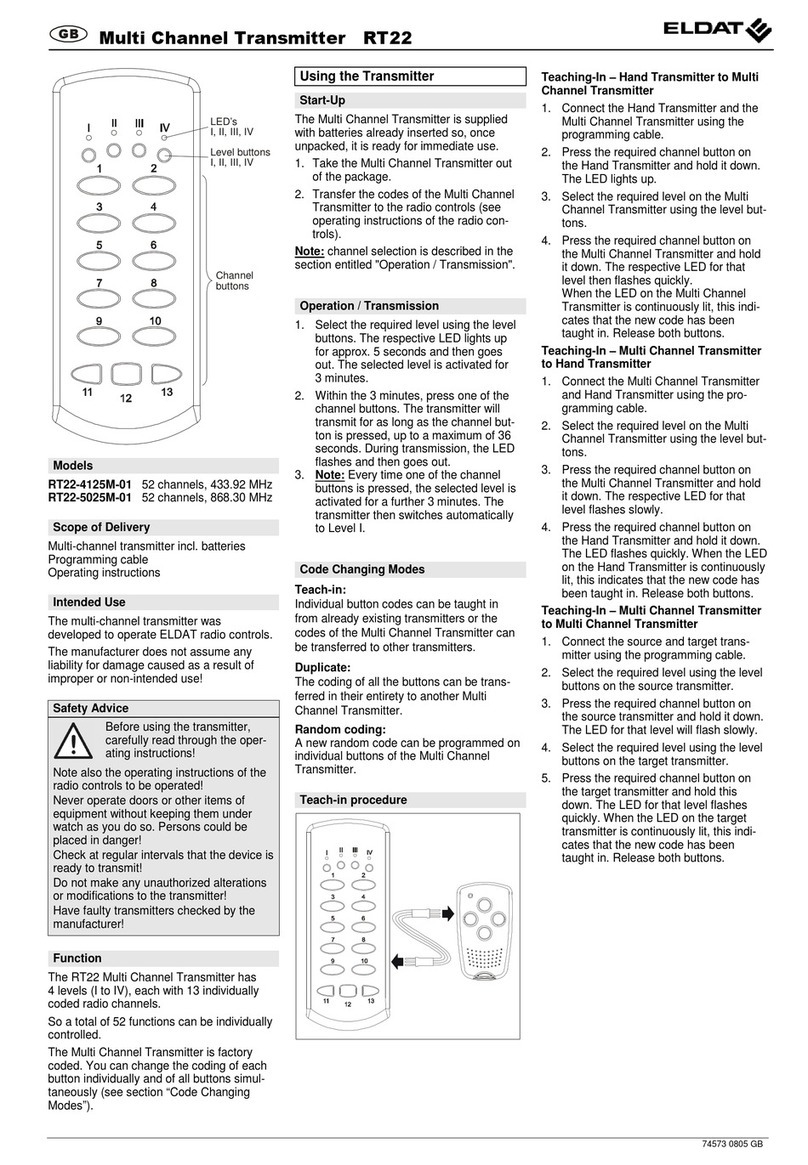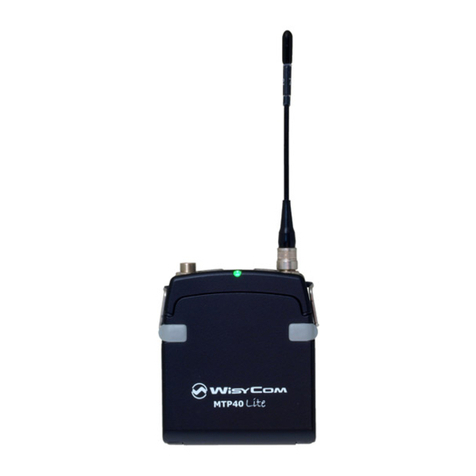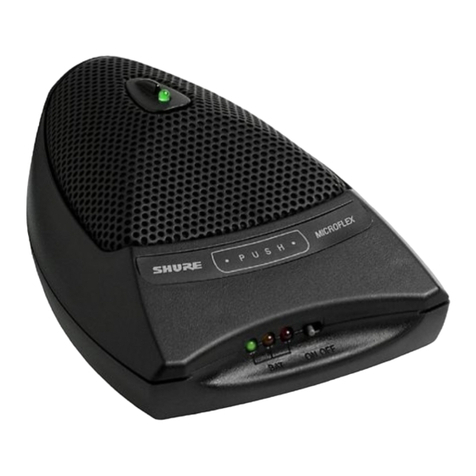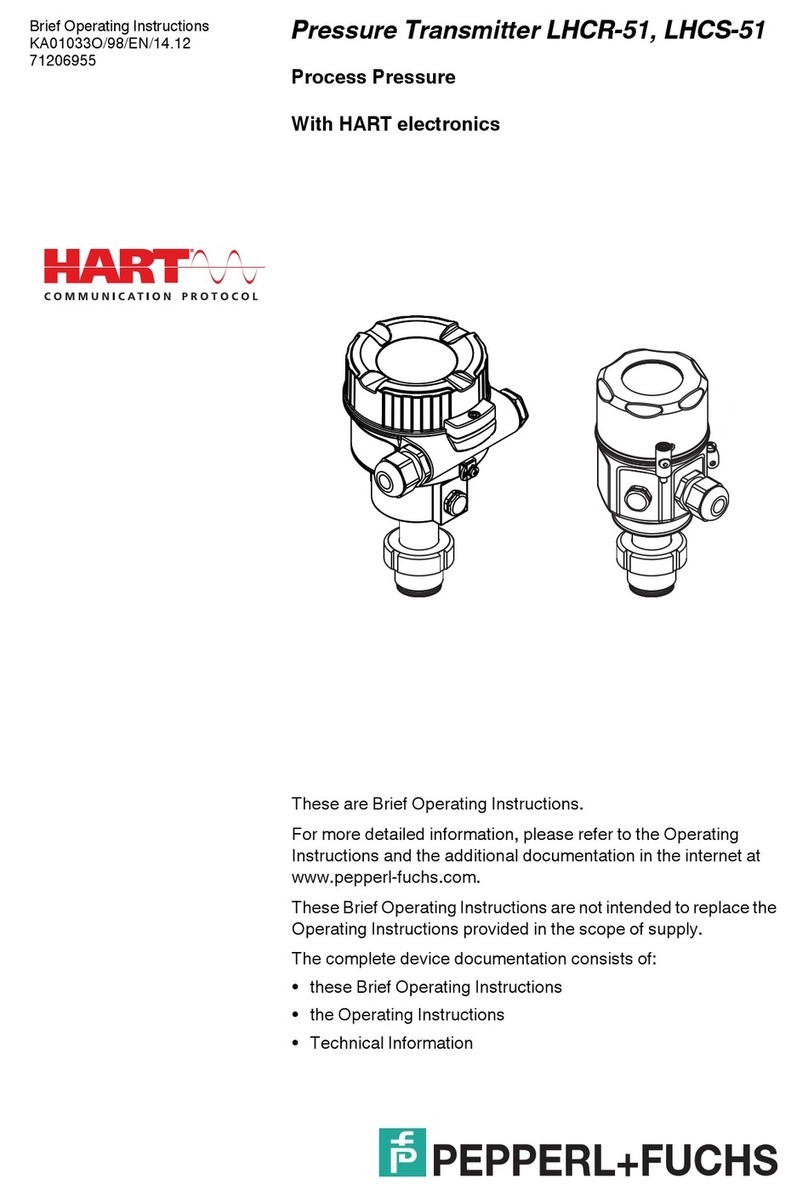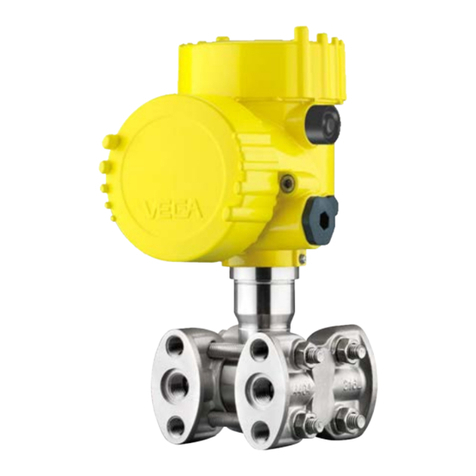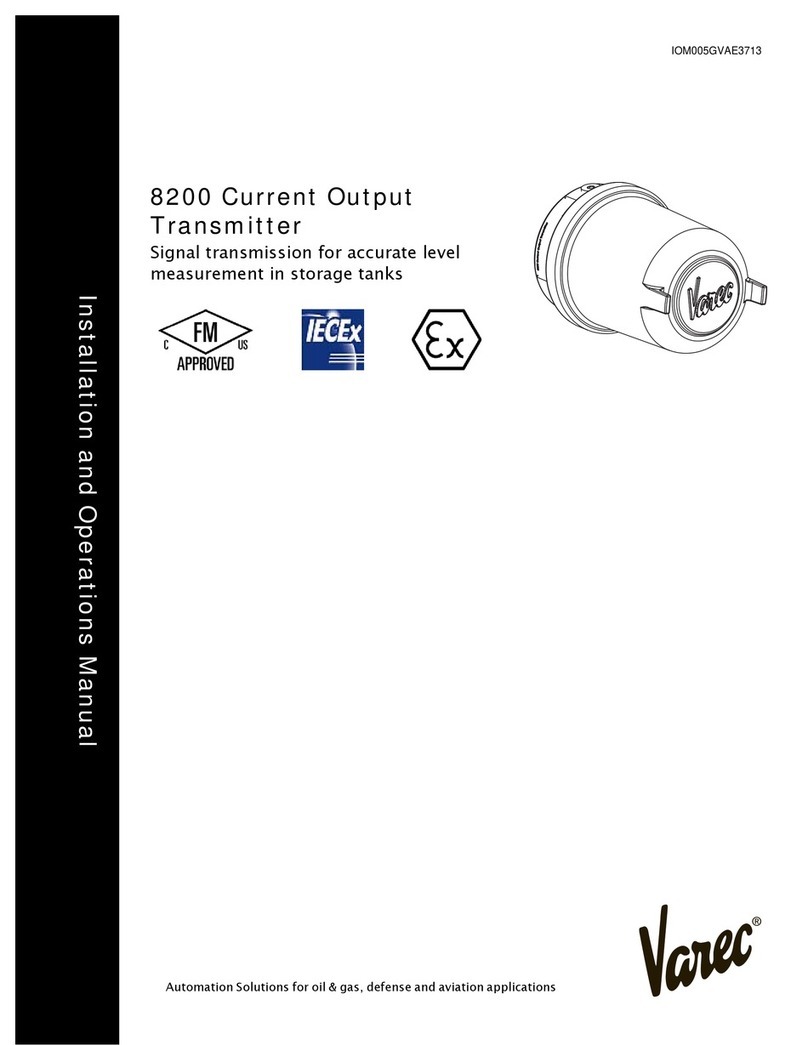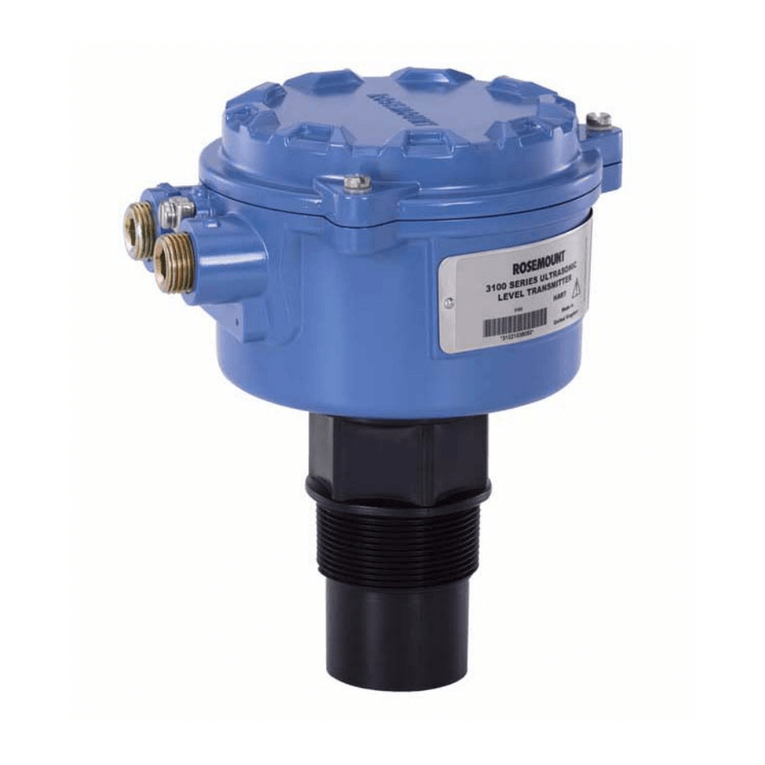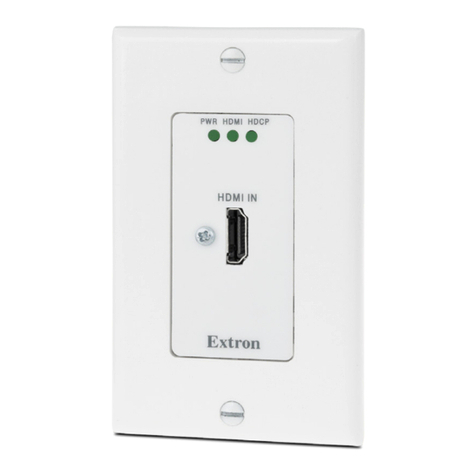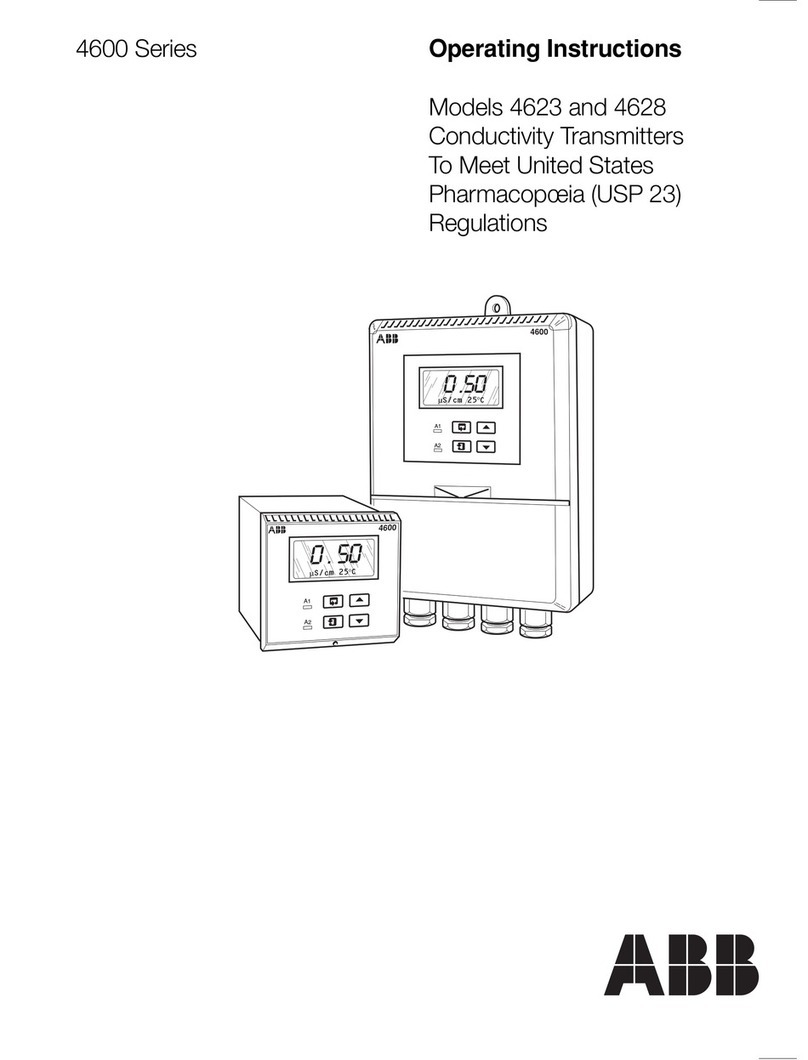Festo SDAT-MHS User manual

SDAT-MHS
en Manual
8080048
2017-11f
[8080050]
Position transmitter

SDAT-MHS
2Festo – SDAT-MHS – 2017-11f
Translation of the original instructions
SDAT-MHS-EN
This documentation refers to the following version: From Revision R04.
Identification of dangers and instructions on how to avoid them:
Warning
Dangers which can lead to death or serious injuries.
Other symbols:
Note
Material damage or loss of function.
Text designations:
Activities which can be carried out in any sequence.
1. Activities which should be carried out in the specified sequence.
– General lists.

SDAT-MHS
Festo – SDAT-MHS – 2017-11f English 3
1 Product description 5.......................................................
1.1 Overview 5................................................................
1.2 Characteristics 5...........................................................
2 Function and application 6...................................................
2.1 Analogue output function 7...................................................
2.2 Switching functions and switching logic 8........................................
2.2.1 Window comparator 8...............................................
2.2.2 Cylinder switch function 9............................................
2.2.3 Hysteresis comparator 9.............................................
2.2.4 Normally open (NO) and normally closed (NC) contacts 9...................
2.3 Switching output operating mode (SIO) 10........................................
2.4 IO-Link operating mode 10....................................................
3 Requirements for product use 11...............................................
4 Installation 13..............................................................
4.1 Electrical 13................................................................
4.2 Mechanical 14..............................................................
5 Commissioning 15...........................................................
5.1 Set set-up mode 15..........................................................
5.2 Scale analogue signal 15......................................................
5.3 Program switching output 16..................................................
5.3.1 Set window comparator 16............................................
5.3.2 Set cylinder switch function 17.........................................
5.3.3 Set hysteresis comparator 18..........................................
5.3.4 Invert switching logic (NO or NC) 18.....................................
5.4 Block / unblock operating key 19...............................................
5.5 Program IO-Link output 19.....................................................
6 Operation 20...............................................................
6.1 Magnetic direction detection and correction 20....................................
6.2 LED indicators 20............................................................
6.3 Reset position transmitter to factory setting 21....................................
7 Disassembly 22.............................................................

SDAT-MHS
4 Festo – SDAT-MHS – 2017-11f English
8 Fault clearance 22...........................................................
8.1 Diagnostics via LED 22........................................................
8.2 General malfunctions 23......................................................
9 Accessories 23..............................................................
10 Technical data 24............................................................
10.1 General 24.................................................................
10.2 IO-Link 25..................................................................
10.3 I-Port 30...................................................................
11 Appendix 31................................................................

SDAT-MHS
Festo – SDAT-MHS – 2017-11f English 5
1 Product description
For all available product documentation èwww.festo.com/pk
1.1 Overview
2
3
4
5
6
7
2
1
1Connecting cable
2Mounting screw
3Plug M8, rotatable
4Red LED: Status display
5Green LED: Ready status display
6Yellow LED: Switching status display
7Operating key
Fig. 1 Control sections and connections
1.2 Characteristics
Feature Order
code
Specification
Position transmitter SDAT-
Mounting M Insertable in slot
Sensing HS- Hall sensor
Sensing range Mxx- Range in mm, xx = 50/80/100/125/160
Operating voltage 124 V DC
Display L- LED
Electrical output SA- PNP or IO-Link and analogue output 4…20 mA
Cable characteristic E- Energy chain + robot
Cable length 0.3- Cable length 0.3 m
Electrical connection M8D M8 rotatable (threaded sleeve)
Tab. 1 Overview of variants

SDAT-MHS
6 Festo – SDAT-MHS – 2017-11f English
2 Function and application
The position transmitter SDAT-MHS is intended for contactless recording of the piston position of mag
netically detectable drives and grippers. It is appropriate for use with Festo drives with T-slot (profile
slot 8) as well as round cylinders and tie-rod cylinders with mounting kits.
Use the SDAT-MHS only for the suitable drives and grippers from Festo èwww.festo.com/
catalogue.
The position transmitter SDAT-MHS records the magnetic field of the piston magnet and continuously
senses the piston movement in the sensing range.
Available output signals include:
– analogue current signal (4…20 mA)
– programmable switching output (24 V),
– IO-Link communication mode (èChapter 2.3).

SDAT-MHS
Festo – SDAT-MHS – 2017-11f English 7
2.1 Analogue output function
The analogue output provides a path-proportional output signal 4…20 mA in the sensing range of the
piston stroke.
– The analogue output signal can be scaled.
– The direction of increase of the analogue output signal can be inverted.
– In the switching output operating mode, the analogue position signal is made available parallel and
independent of the position value output of the switching output.
– The analogue output is switched off in the operating mode IO-Link.
0 mm x mm
2 mA
4 mA
20 mA
AB C
x = Maximum length of the sensing range (type-dependent)
Fig. 2 Characteristic curve, analogue output
Signal Description Area1)
0 mA – IO-Link operation
– error (e.g. broken cable, parameter error)
2 mA – piston outside of the sensing range after the operating voltage is
switched on
A, C
4 mA – the piston has left the sensing range in the direction of the falling
output current
A
>4 mA ... <20 mA – piston within the sensing range B
20 mA – the piston has left the sensing range in the direction of the rising
output current
C
1) Area èFig. 2, Area A and C: Red LED illuminated
Tab. 2 Output signal, analogue output
Note
With active IO link communications, the analog output is switched off
(output current = 0 mA).

SDAT-MHS
8 Festo – SDAT-MHS – 2017-11f English
Scaling of the analogue signal
The analogue output signal 4…20 mA is assigned as standard to the complete sensing range. If only a
part of the sensing range is used, the analogue value output can be scaled to the sensing range actually
used. Resolution and repetition accuracy are not improved through scaling.
2 mA
20 mA
4 mA
0 mm 60 mm 120 mm 160 mm
12
Scaled
Not scaled
Analogue signal
1Teach point 1
2Teach point 2
Fig. 3 Scaling of the analogue signal (example SDAT-MHS-M160)
2.2 Switching functions and switching logic
2.2.1 Window comparator
OUT
IN
Switching travel
hysteresis
12
1Teach point 1
2Teach point 2
Fig. 4 Window comparator
The teach points (1,2) are linked to the window comparator function.
– The position of the teach points determines the window width.
– Hysteresis is not selectable or preset.

SDAT-MHS
Festo – SDAT-MHS – 2017-11f English 9
2.2.2 Cylinder switch function
OUT
IN
1
Switching travel
hysteresis
1Teach point
Fig. 5 Cylinder switch function
The cylinder switch function consists of the switching travel and hysteresis. Hysteresis serves to sup
press switching signals in the event of fluctuations around the switching point.
– The teach value is the middle of the switching travel.
– Switching travel and hysteresis are not adjustable. For switching travel and hysteresis, values are
stored that correspond to a typical electronic cylinder switch in a typical drive.
2.2.3 Hysteresis comparator
OUT
IN
1
2
Switching travel
1Teach point 1
2Teach point 2
Fig. 6 Hysteresis comparator
The teach points (1,2) are linked to the hysteresis comparator function.
– Teach point 1 (ON) is the switch-on point, teach point 2 (OFF) is the reset point.
– Teach point 2 establishes the size of the hysteresis.
2.2.4 Normally open (NO) and normally closed (NC) contacts
The switching logic normally open (NO) is set as standard. The function of the switching output is inver
ted through selection of the normally closed function (NC).

SDAT-MHS
10 Festo – SDAT-MHS – 2017-11f English
2.3 Switching output operating mode (SIO)
If the IO-Link/switching output is operated as a switching output, only 1 binary channel can be pro
grammed. The switching output operating mode must be programmed actively via set-up mode (key)
(èChapter 5.3).
– Either window comparator or cylinder switch function or hysteresis comparator programmable.
– Switching logic normally closed (NC) or normally open (NO) selectable.
– Programming via IO-Link protocol (channel BDC1) or operating key on the device.
– Display switching output ON: Yellow LED illuminated.
– Output signal 24 V DC (PNP).
Note
Even if the analogue output has been scaled, the switching output can still be pro
grammed over the entire sensing range.
2.4 IO-Link operating mode
In the IO-Link operating mode, programmed switching signals and the continuous position values (digit
ally coded analogue values) are transferred.
– There are 4 binary channels available, which can be programmed individually as window comparator
or cylinder switch or hysteresis comparator.
– The continuous position values are always transferred parallel and independent of the position
value output of the binary channels.
– Each channel is adjustable as normally closed (NC) or normally open (NO).
– Data transmission is serially and digitally coded in the IO-Link protocol.
– Process data: 12 bit for position data and 4 bit for binary channels (èChapter 10).
– Usage of unscreened standard cables of up to 20 m in length is possible.
– Device description file IODD for every device length èwww.festo.com/sp.
– Parameters and functions in accordance with Smart-Sensor profile.
– Support of optional functions Block Parameterisation and Data Storage.
– Display IO-Link operation: Green LED flashes (1 Hz).
– Inversion of direction of process data values (PDV).
PDV is minimally (standard) or maximally (inverted) at the cable end of the sensor.

SDAT-MHS
Festo – SDAT-MHS – 2017-11f English 11
3 Requirements for product use
Use the product in its original status, without any unauthorised product modifications.
Use the SDAT-MHS only for the suitable drives from Festo (èwww.festo.com/catalogue).
Avoid having magnetic bodies near the position transmitter. These could influence the magnetic
field and thereby the behaviour of the sensor.
Do not exceed the limit values (e.g. voltages, forces, temperatures).
Take into consideration the ambient conditions at the location of use.
This product can generate high frequency interference, which may make it necessary to implement
interference suppression measures in residential areas.
Observe the regulations which apply in your location (e.g. from trade associations or from national
institutions).
Remove all transport packaging. The material used in the packaging has been specifically chosen
for its recyclability (with the exception of the oil-impregnated paper which is residual waste).
Areas of application and approval by authorities
In connection with the UL marking on the product, the information of this section is applicable for com
pliance with the certification conditions of Underwriters Laboratories Inc. (UL) for the U.S.A. and
Canada. Observe the following remarks from UL:
UL approval information
Product category code NRKH, NRKH7
File number E232949
Considered standards UL 60947-1 and UL 60947-5-2, C22.2 No. 14-13
UL mark
Product category
Control Number
Ind. Cont. EQ.
(Industrial Control Equipment)
2MD1

SDAT-MHS
12 Festo – SDAT-MHS – 2017-11f English
Only for connection to a NEC Class 2 supply.
Raccorder Uniquement a un circuit de Classe 2.
This device is intended to be used with a Class 2 power source or Class 2 transformer in accordance
with UL1310 or UL1585.
As an alternative a LV/C (Limited Voltage/Current) power source with one of the following properties
can be used:
– This device shall be used with a suitable isolating source such that the maximum open circuit
voltage potential available to the product is not more than 30 V DC and the current is limited to a
value not exceeding 8 amperes measured after 1 minute of operation.
– This device shall be used with a suitable isolating source in conjunction with a fuse in accordance
with UL248. The fuse shall be rated max. 3.3 A and be installed in the 30 V DC power supply to the
device in order to limit the available current.
Note that, when more than one power supply or isolating device is used, connection in parallel is not
permitted.
Electrical and environmental ratings
Input voltage Max. 30 V DC, Class 2
Input current 160 mA / max. 4.8 W
Analog output 4–20 mA
Transistor output max. 30 V DC, 100 mA G.P.
Maximum Ambient Temperature 70 °C / 158 °F
Enclosure Type Rating Type 1

SDAT-MHS
Festo – SDAT-MHS – 2017-11f English 13
4 Installation
Installation and commissioning must be carried out only by properly qualified personnel in accordance
with these operating instructions.
4.1 Electrical
Warning
Risk of injury due to electric shock.
For the electric power supply, use only PELV circuits that ensure a reliable electric
disconnection from the mains network.
Observe IEC 60204-1/EN 60204-1.
Switched-mode power supplies are permitted, provided that they ensure reliable
separation in accordance with EN60950/VDE0805.
1. Make sure that the operating voltage is switched off.
2. Connect the M8 plug to the connecting cable of the higher-order controller.
– The tightening torque for the union nut of the plug: Max. 0.3 Nm.
Fig. 7 Circuit diagram
Pin Allocation Plug
1Operating voltage +24 V DC M8x1, 4-pin
2Analogue output 0…20 mA
30 V
4IO-Link/switching output (C/Q line)
Tab. 3 Pin allocation of plug connection

SDAT-MHS
14 Festo – SDAT-MHS – 2017-11f English
4.2 Mechanical
The mounting position is any desired.
0.5 Nm
ß1.5
0.3 Nm
1
2
3
4
1Internal hexagon socket key
2Mounting screw
3T-slot (profile slot 8)
4M8 plug
Fig. 8 Mechanical installation
1. Insert the SDAT-MHS into the T-slot of the drive.
2. Move the piston into an end position of the application.
3. Push the SDAT-MHS in the direction of the piston until the red LED goes out.
4. Tighten the mounting screws hand-tight.
– max. tightening torque 0.5 Nm.
– tool: Internal hexagon socket key (size 1.5 mm).

SDAT-MHS
Festo – SDAT-MHS – 2017-11f English 15
5 Commissioning
Installation and commissioning may only be performed in accordance with these instructions by techni
cians with appropriate qualifications.
1. Switch on the operating voltage.
èThe LEDs illuminate (dependent on the piston position èTab. 4).
èThe device is ready for operation.
5.1 Set set-up mode
1. Press the operating key 3 times within 3 s.
èSet-up mode: Green and yellow LED flash simultaneously.
Note
After entry into the set-up mode, if programming is not completed within 60 s, the
SDAT-MHS automatically switches into the operating mode
5.2 Scale analogue signal
2 mA
20 mA
4 mA
0 mm 60 mm 120 mm 160 mm
12
Scaled
Not scaled
Analogue signal
1Teach point 1
2Teach point 2
Fig. 9 Scaling of the analogue signal (example SDAT-MHS-M160)
Requirement: The piston is in the sensing range (red LED off).
1. Change into the set-up mode (èChapter 5.1).
2. Press the operating key 5 times in succession.
èScale analogue output: The green LED flashes (5 times briefly in succession within 2 s).
3. Move the piston to the starting point of the desired sensing range.
4. Press the operating key.
èTeach point 1 (starting point of the sensing range) is established (4 mA).
èGreen LED continues to flash, yellow LED flashing at 1 Hz.
5. Move the piston to the end point of the desired sensing range.

SDAT-MHS
16 Festo – SDAT-MHS – 2017-11f English
6. Press the operating key.
èTeach point 2 (end point of the sensing range) is established (20 mA).
èChange into the operating mode.
Note
To invert the direction of increase of the analogue signal: Set teach point 2 (20 mA) on
the cylinder axis before teach point 1 (4 mA).
5.3 Program switching output
5.3.1 Set window comparator
OUT
IN
Switching travel
hysteresis
12
1Teach point 1
2Teach point 2
Fig. 10 Window comparator
Requirement: The piston is in the sensing range (red LED off).
1. Change into the set-up mode (èChapter 5.1).
2. Press the operating key 1 time.
èGreen LED flashes (1 time within 2 s).
3. Move the piston to the 1st switching point (teach point 1).
4. Press the operating key 1 time.
èSwitching point 1 is established.
èGreen LED continues to flash, yellow LED flashing at 1 Hz.
5. Move the piston to the 2nd switching point (teach point 2).
6. Press the operating key 1 time.
èSwitching point 2 is established.
èChange into the operating mode.

SDAT-MHS
Festo – SDAT-MHS – 2017-11f English 17
5.3.2 Set cylinder switch function
OUT
IN
1
Switching travel
hysteresis
1Teach point
Fig. 11 Cylinder switch function
Requirement: The piston is in the sensing range (red LED off).
1. Change into the set-up mode (èChapter 5.1).
2. Press the operating key 2 times.
èGreen LED flashes (2 times briefly in succession within 2 s).
3. Move the piston to the switching point (teach point 1).
4. Press the operating key 1 time.
èThe switching point is established.
èChange into the operating mode.

SDAT-MHS
18 Festo – SDAT-MHS – 2017-11f English
5.3.3 Set hysteresis comparator
OUT
IN
1
2
Switching travel
1Teach point 1
2Teach point 2
Fig. 12 Hysteresis comparator
Requirement: The piston is in the sensing range (red LED off).
1. Change into the set-up mode (èChapter 5.1).
2. Press the operating key 3 times.
èGreen LED flashes (3 times briefly in succession within 2 s).
3. Move the piston to the switch-on point (teach point 1).
4. Press the operating key 1 time.
èThe switch-on point is established.
èGreen LED continues to flash, yellow LED flashing at 1 Hz.
5. Move the piston to the reset point (teach point 2).
6. Press the operating key 1 time.
èThe reset point is established.
èChange into the operating mode.
5.3.4 Invert switching logic (NO or NC)
1. Change into the set-up mode (èChapter 5.1).
2. Press the operating key 4 times.
èGreen LED flashes (4 times briefly in succession within 2 s).
èYellow LED illuminated: Currently set switching logic is NC.
èYellow LED not illuminated: Currently set switching logic is NO.
3. Press the operating key.
èThe switching logic is inverted.
èChange into the operating mode.

SDAT-MHS
Festo – SDAT-MHS – 2017-11f English 19
5.4 Block / unblock operating key
In the IO-Link mode, the operating key is automatically and always blocked.
In the switching output operating mode, the operating key is unlocked as standard. But it can be
blocked in the IO-Link mode for the switching output operating mode:
1. Produce IO-Link mode.
2. Select key block for switching output operating mode in the IO-Link parameter menu:
– device access block,
– local user interface block.
LED display with blocked operating key:
– If the operating key is pressed: Green LED flashes 3 seconds at 3 Hz.
– Yellow LED displays the current status of the switching output.
– Red LED is illuminated only when the piston is outside the sensing range.
5.5 Program IO-Link output
The IO-Link function cannot be set via the operating keys on the device. All settings for set-up, commis
sioning and parameterisation are made in the higher-level controller of the IO-Link master.
1. Load the device description file IODD (èwww.festo.com/sp) belonging to the device into the
interpreter of the IO-Link masters.
2. Connect the IO-Link/switching output to the IO-Link master.
3. Program the device. Observe the instructions on this in the operating instructions of the IO-Link
masters.
Note
If the device detects an error during commissioning, it is displayed on the user interface
of the IO-Link master and the programming option is closed.

SDAT-MHS
20 Festo – SDAT-MHS – 2017-11f English
6 Operation
6.1 Magnetic direction detection and correction
At initial start-up or after a reset to factory settings, the position sensor emits signals directly using the
currently detected magnetic direction.
The magnetic direction detection and, with it, the signal curve are corrected during ongoing operation
when the following cases occur:
– The position sensor was placed in operation in a position where a correct magnetic direction detec
tion was not possible (e.g. due to ferromagnetic materials near the sensor or within the drive or
gripper).
– The position sensor was turned 180° in the slot after the magnetic direction was recognised as
stable.
Note
Brief incorrect signals at the sensor output can occur if automatic correction of the
magnetic direction detection is required èChapter 8.2.
6.2 LED indicators
Status signals in normal operation
LED indicator Description
Yellow Green Red
Green LED illuminated: Ready status (yellow: Any, red: Off ).
– Analogue output function or switching output operating mode.
– Piston within the sensing range.
Green LED flashing at 1 Hz: Ready status.
– IO-Link operating mode.
Yellow and green LEDs illuminated: Ready status.
– Switching output switched.
– Piston in the range of a programmed function.
Green LED flashing 3 seconds at 3 Hz while the operating key is pressed:
Operating key blocked.
Red LED illuminated: Status display.
– Piston outside the sensing range.
Tab. 4 LED displays in normal operation
Other manuals for SDAT-MHS
2
Table of contents
Other Festo Transmitter manuals
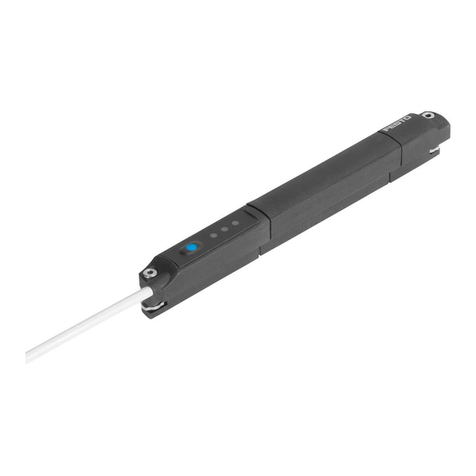
Festo
Festo SDAT-MHS-SV Series User manual

Festo
Festo SDAT-MHS SA Series Reference guide
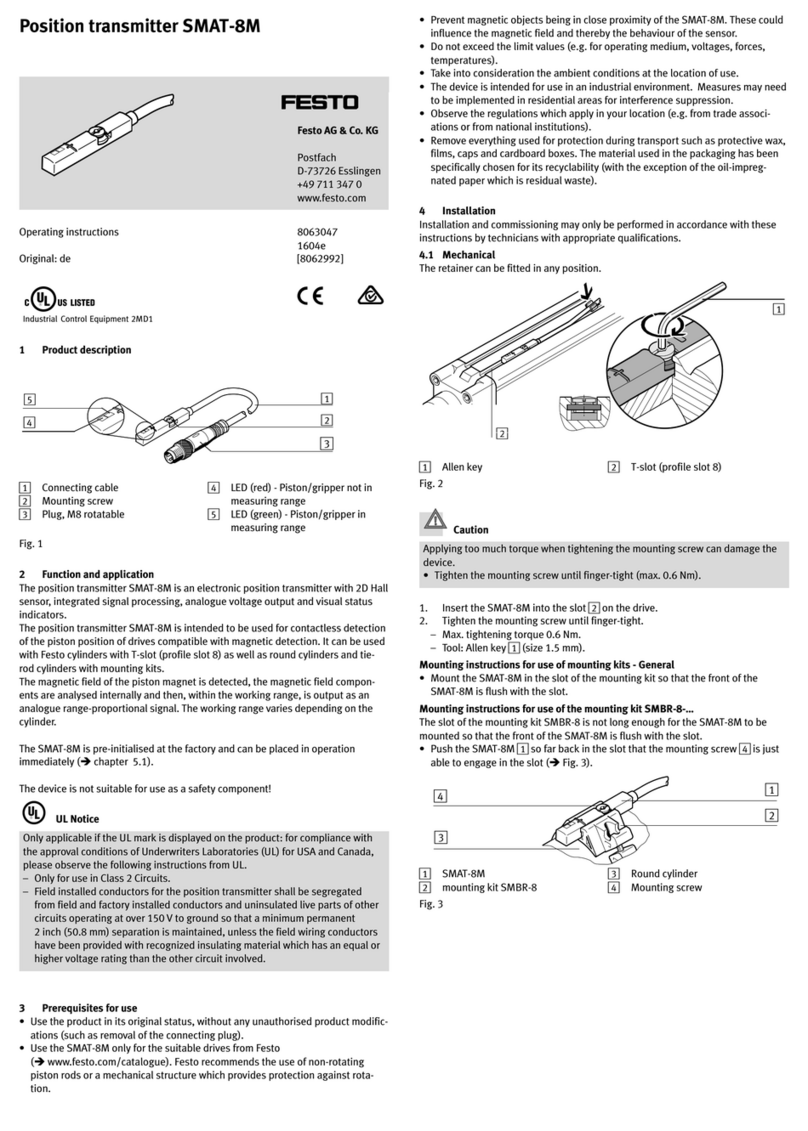
Festo
Festo SMAT-8M User manual

Festo
Festo SDAT-MHS-SV Series Reference guide

Festo
Festo SDAS-MHS User manual
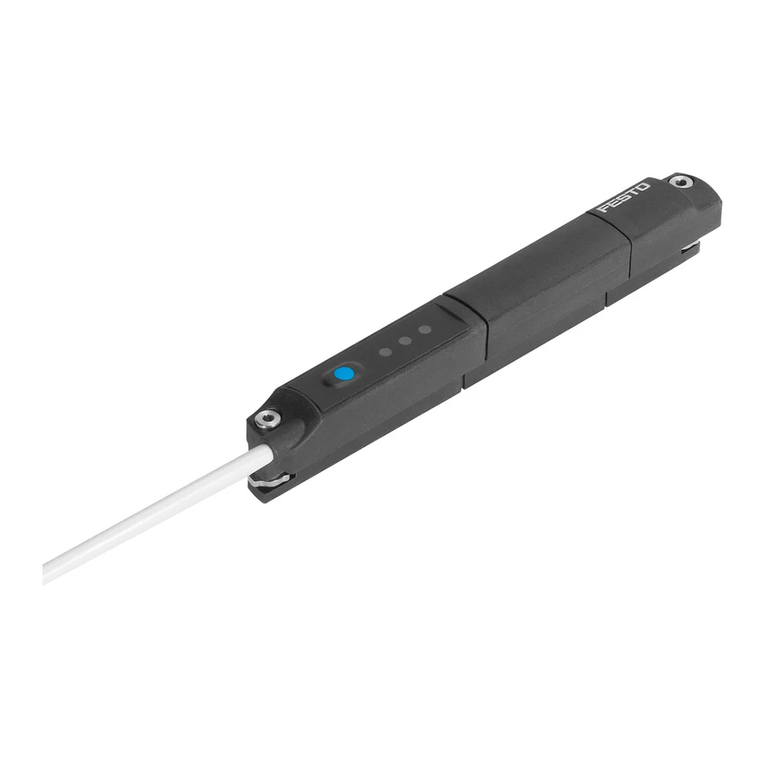
Festo
Festo SDAT-MHS User manual

Festo
Festo SDAS-MHS User manual
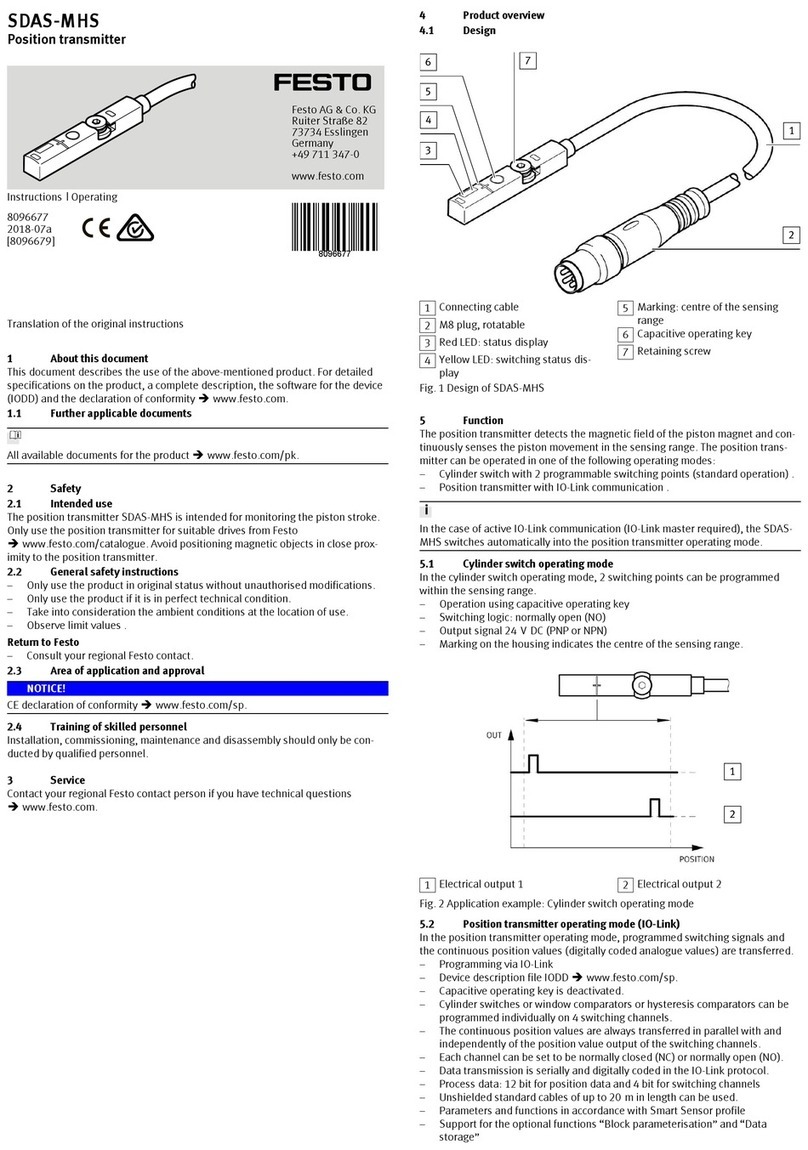
Festo
Festo SDAS-MHS User manual
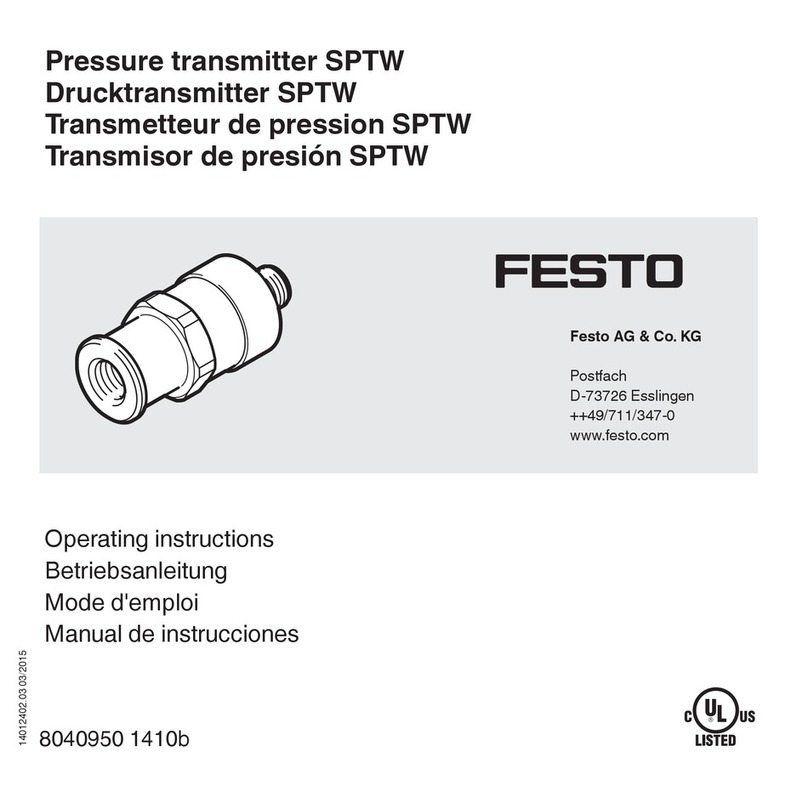
Festo
Festo SPTW Series User manual
Popular Transmitter manuals by other brands

Sennheiser
Sennheiser Tourguide Wireless Transmitter SR 2020 D instruction manual
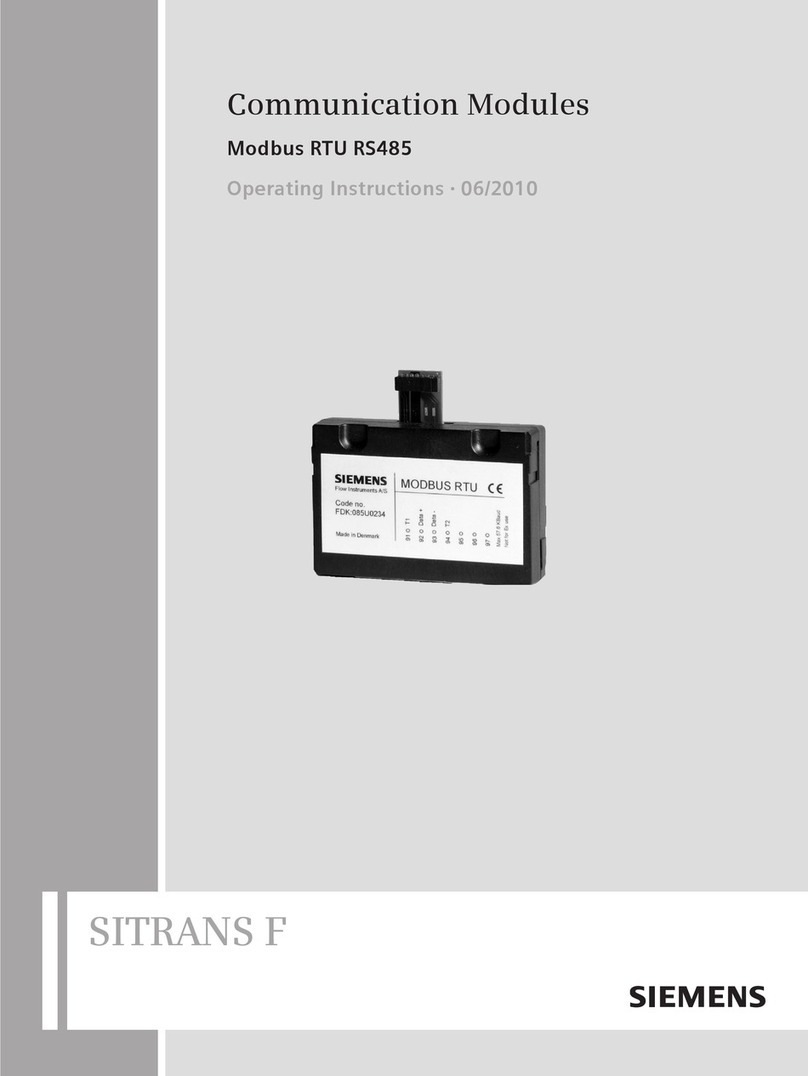
Siemens
Siemens SITRANS F operating instructions
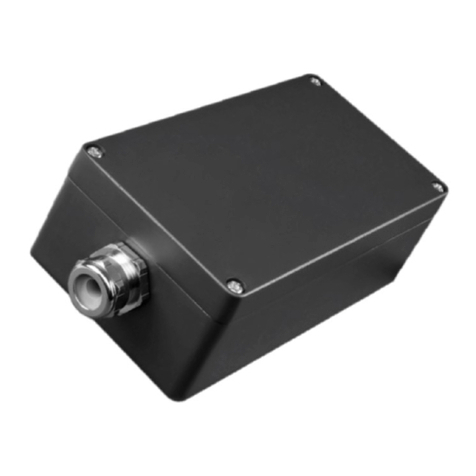
Baumer
Baumer LWL-SBR Installation and operating instructions
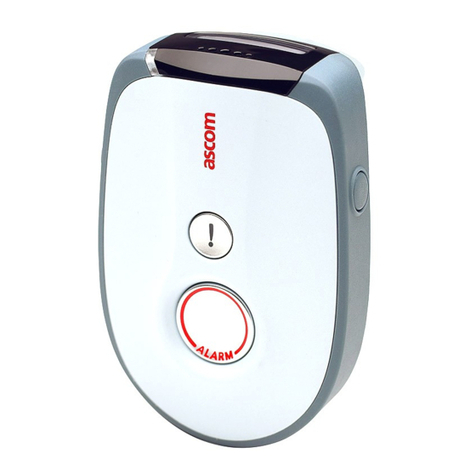
ASCOM
ASCOM A51 - Quick reference guide

Bracketron
Bracketron RoadTripper BT5-548-2 user manual
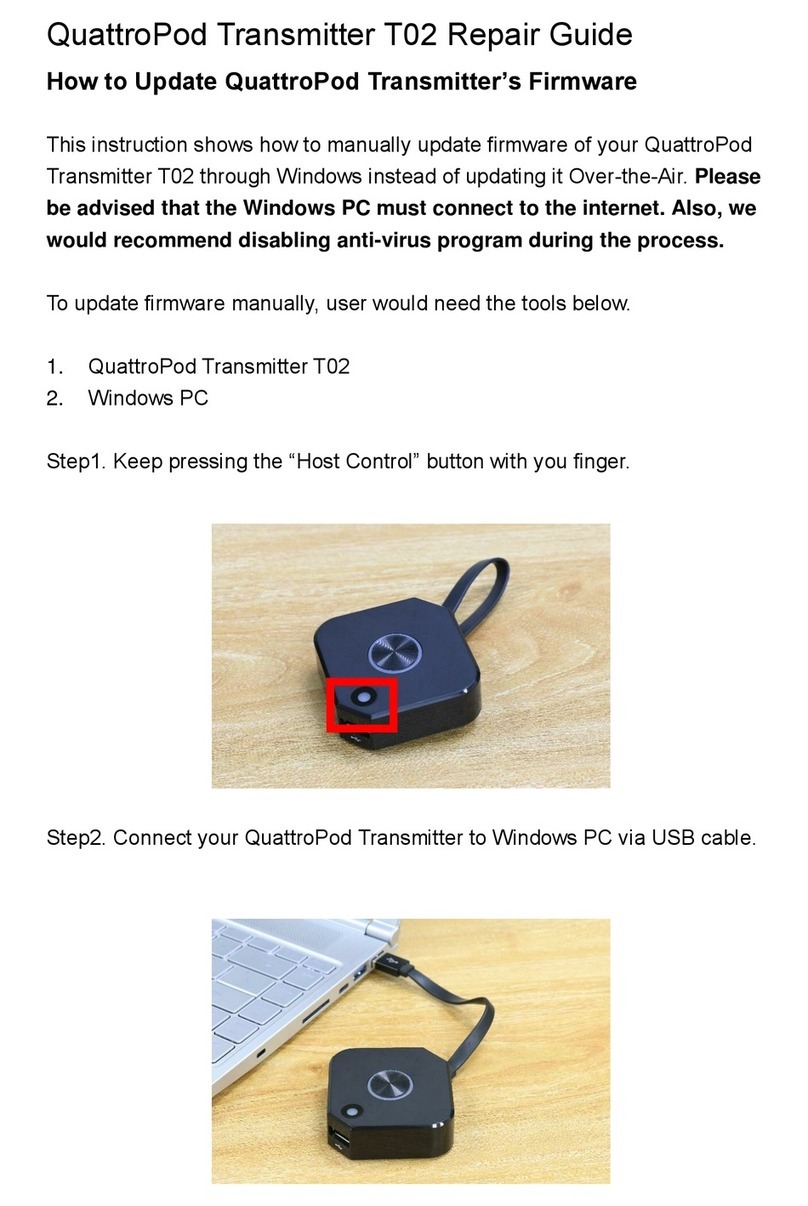
EZCast
EZCast QuattroPod T02 Repair guide
